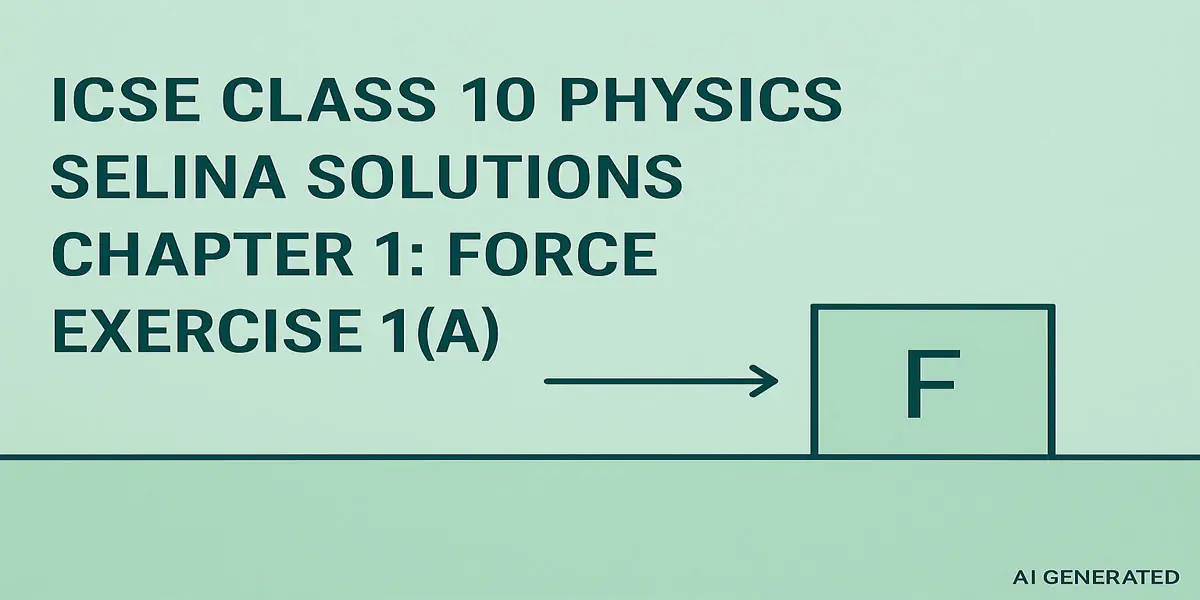Introduction
Looking for ICSE Class 10 Selina Concise Physics Chapter 1 Force Exercise 1(A) Solutions? You’ve landed at the right place! Selina Concise Physics is a trusted resource for ICSE students, and Chapter 1 on Force lays the foundation for understanding key concepts like moment of force, equilibrium, and translational and rotational motion. Here, we provide clear, step-by-step solutions for Exercise 1(A) to help you ace your exams.
ICSE Class 10 Force Selina Exercise 1(A) Solutions
We provide step-by-step solutions to all questions from Exercise 1(A) of the Selina Physics textbook. Each answer includes:
- Clear explanations based on ICSE marking scheme
- Diagrams wherever necessary
- Formulas used for numericals
- Units and SI conventions
(A) Multiple Choice Type : Exercise 1(A)
(Choose the correct answer from the options given below).
Question 1
The motion of a stationary rigid body in a straight path when a force is applied in the direction of force is called :
(a) rotational motion (b) linear motion
(c) angular motion (d) zigzag motion
Answer:
(b) linear motion
Explanation: When a force is applied in the direction of the center of mass of a stationary rigid body, it causes the body to move in a straight line without rotation. This type of motion is called linear motion.
Question 2
The motion of a door when a force is applied on its handle is :
(a) rotational motion (b) linear motion
(c) angular motion (d) zig-zag motion
Answer:
(a) rotational motion
Explanation: A door is fixed at hinges (a pivot), and when force is applied at the handle, it rotates about the hinges. This is a case of rotational motion around a fixed axis.
Question 3
The moment of a force about a given axis depends on:
(a) only on the magnitude of force
(b) only on the perpendicular distance of force from the axis
(c) neither the force nor the perpendicular distance of force from the axis
(d) both, the force and its perpendicular distance from the axis.
Answer:
(d) both, the force and its perpendicular distance from the axis.
Explanation: Moment of force (also called torque) is given by:
Moment = Force × Perpendicular distance from axis
So it depends on both these factors.
Question 4
For producing the maximum turning effect on a body by a given force, the perpendicular distance of the line of force from the axis of rotation should be :
(a) minimum (b) it does not matter
(c) maximum (d) zero
Answer:
(c) maximum
Explanation: The greater the perpendicular distance from the axis, the larger the moment (turning effect) for the same force. Hence, maximum distance gives maximum moment.
Question 5
The moment of force for anticlockwise moment is taken as …………… and for clockwise moment is taken as ……………
(a) positive, negative (b) negative, positive
(c) positive, positive (d) negative, negative
Answer:
(a) positive, negative
Explanation: By convention, anticlockwise moments are considered positive, and clockwise moments are negative when applying the principle of moments.
Question 6
The direction of rotation of a pivoted body can be changed by changing:
(a) the direction of force
(b) the point of application of force
(c) both the direction of force and the point of application of force
(d) the magnitude of force
Answer:
(c) both the direction of force and the point of application of force
Explanation: Changing either the direction of the force or where it is applied affects how the torque acts. If both are changed, the direction of rotation of the body can be completely reversed.
Question 7
A couple is formed when …………… are not acting along the same line.
(a) two unequal and parallel forces
(b) two equal and parallel forces
(c) two equal and opposite parallel forces
(d) two unequal and opposite parallel forces
Answer:
(c) two equal and opposite parallel forces
Explanation: A couple is a pair of equal and opposite forces whose lines of action do not coincide (they are parallel but separated). This results in rotation without translation.
Question 8
As per the principle of moments in equilibrium :
(a) Sum of anticlockwise moments is greater than sum of clockwise moments
(b) Sum of anticlockwise moments is equal to sum of clockwise moments
(c) Sum of anticlockwise moments is less than sum of clockwise moments
(d) none of the above
Answer:
(b) Sum of anticlockwise moments is equal to sum of clockwise moments
Explanation: For an object to be in rotational equilibrium, the net moment must be zero. That is,
Anticlockwise moments = Clockwise moments
Question 9
A body is acted upon by two unequal forces in opposite directions, but not in the same line. The effect is that:
(a) the body will only have rotational motion
(b) the body will only have translational motion
(c) the body will have neither rotational motion nor translational motion
(d) the body will have rotational as well as translational motion.
Answer:
(d) the body will have rotational as well as translational motion.
Explanation: Unequal and non-collinear (not on the same line) forces will produce:
A net force → causes translation
A net torque → causes rotation
So both motions occur.
Question 10
Out of the following which one is an example of dynamic equilibrium ?
(1) Moon revolving around the earth
(2) A pebble fixed at the end of a string whirling in a circular path
(3) An aeroplane moving at a constant height
(4) A beam balance balanced in a horizontal position.
(a) (3) and (4)
(b) (1), (2) and (3)
(c) (1) and (2)
(d) (1) and (3)
Answer:
(b) (1), (2) and (3)
Explanation: Dynamic equilibrium refers to a condition where a body is in motion, but the net force and net torque acting on it is zero.
The object moves with constant velocity (no acceleration).
Forces acting on the body are balanced.
(B) Very Short Questions : Exercise 1(A)
Question 1
State the condition when on applying a force, a body has:
(a) translational motion
(b) rotational motion.
Answer:
(a) A body undergoes translational motion when a body is free to move.
(b) A body undergoes rotational motion when the body is pivoted or fixed at a point.
Question 2
State whether the moment of force is a scalar or vector quantity?
Answer:
The moment of force is a vector quantity.
Question 3
Write the expression for the moment of force about a given axis.
Answer:
Moment of force = Force × perpendicular distance of force from the axis of rotation.
Question 4
State one way to reduce the moment of a given force about a given axis of rotation.
Answer:
The moment of force can be reduced by decreasing the perpendicular distance of force from the axis of rotation.
Question 5
State one way to obtain a greater moment of a force about a given axis of rotation.
Answer:
We can obtain a greater moment of force by increasing the perpendicular distance of force from the axis of rotation
Question 6
Complete the following sentences:
(i) The S.I. unit of moment of force is ……………
(ii) In equilibrium algebraic sum of moments of all forces about the point of rotation is …………….
(iii) In beam balance when the beam is balanced in a horizontal position, it is in …………… equilibrium.
(iv) The moon revolving around the earth is in ……………equilibrium.
Answer:
(i) The S.I. unit of moment of force is Newton metre (Nm).
(ii) In equilibrium algebraic sum of moments of all forces about the point of rotation is zero.
(iii) In beam balance when the beam is balanced in a horizontal position, it is in static equilibrium.
(iv) The moon revolving around the earth is in dynamic equilibrium.
(C) Short Questions : Exercise 1(A)
Question 1
Define moment of force and state its S.I. unit.
Answer:
The moment of a force is the product of the force and the perpendicular distance from the axis of rotation to the line of action of the force.
The S.I unit of moment of force is Newton meter (Nm).
Question 2
State two factors affecting the turning effect of a force.
Answer:
Two factors affecting the turning effect of a force are:
(i) Magnitude of the force applied
(ii) Perpendicular distance from the axis of rotation
Question 3
When does a body rotate? State one way to change the direction of rotation of a body. Give a suitable example to explain your answer.
Answer:
If a body is pivoted at a point and the force is applied on the body at a suitable point, it rotates the body about the axis passing through the pivoted point.
The direction of rotation can be changed by changing the direction of force.
Figures given below shows the clockwise and anticlockwise movement in a circle pivoted at the centre by changing the point of application of force F from A to point B.
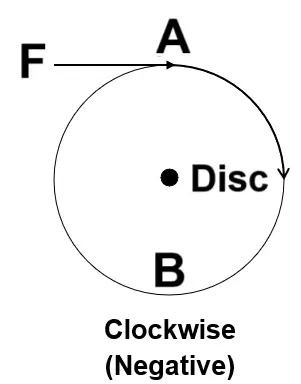

Question 4
What do you understand by the clockwise and anticlockwise moment of force? When is it taken positive?
Answer:
Clockwise Moment: When a force causes an object to rotate in the clockwise direction, the moment is called a clockwise moment. A clockwise moment is taken as negative.
Anticlockwise Moment: When a force causes an object to rotate in the anticlockwise direction, the moment is called an anticlockwise moment. An anticlockwise moment is taken as positive.
Question 5
Why is it easier to open a door by applying the force at the free end of it?
Answer:
It is easier to open the door by applying the force at the free end because when the perpendicular distance is large less force is required to turn the body.
Question 6
The stone of hand flour grinder is provided with a handle near its rim. Give a reason.
Answer:
The stone of hand flour grinder is provided with a handle near its rim because by applying small force at the handle it can be rotated easily about the iron pivot at its centre.
Question 7
It is easier to turn the steering wheel of a large diameter than that of a small diameter. Give reason.
Answer:
It is easier to turn the steering wheel of a large diameter than that of a small diameter because less force is applied on steering of large diameter which is at a large distance from the centre of rim.
Question 8
A spanner (or wrench) has a long handle. Why?
Answer:
A spanner (or wrench) has a long handle to produce larger turning moment so that nut can easily be turned with a less force.
Question 9
A jack screw is provided with a long arm. Explain why?
Answer:
A jack screw used to lift a heavy vehicle is designed with a long arm so that it requires less force to rotate and raise or lower the vehicle.
Question 10
The adjacent diagram shows a heavy roller, with its axle at O, which is to be raised on a pavement XY. If there is friction between the roller and pavement, show by an arrow on the diagram the point of application and the direction of force to be applied. If pivoted at 0, now will it go up?
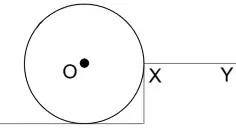
Answer:
Application of Force has to be done as shown in the diagram.
No, if pivoted at O it will not go up.
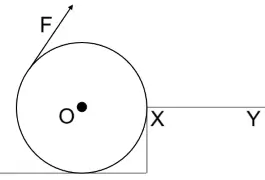
Question 11
Define the moment of a couple. Write its S.I unit.
Answer:
Moment of couple is product of either force and the perpendicular distance between the two forces.
The S.I unit of moment of couple is Newton meter (Nm).
Question 12
What do you mean by equilibrium of a body?
Answer:
When several forces acting on a body produce no change in its state of rest or of linear or rotational motion, the body is said to be in equilibrium.
Question 13
State the condition when a body is in
(i) static equilibrium.
(ii) dynamic equilibrium.
Give one example each of static and dynamic equilibrium.
Answer:
Static equilibrium : When a body remains in the state of rest under the influence of several forces, the body is said to be in static equilibrium.
Example :
(a) A book lying on a table
(b) Beam balance in horizontal balance
(c) Book on the table
Dynamic equilibrium : When a body remains in the same state of motion under the influence of several forces, the body is said to be in dynamic equilibrium.
Example :
(a) A rain drop reaches the earth surface with a constant velocity.
(b) Aeroplane moves at the constant height
(c) Stone tied at the end of the string
(d) Revolution of moon around the earth
Question 14
State two conditions for a body, acted upon by several forces to be in equilibrium.
Answer:
The two conditions for a body to be in equilibrium are :
- Translational Equilibrium: The sum of all forces acting on the body must be zero.
- Rotational Equilibrium: Algebraic sum of moments of all forces acting on the body about a point of rotation must be zero.
Question 15
State the principle of moments. Name one device based on it.
Answer:
Principle of Moments:
When a body is in equilibrium, the sum of the clockwise moments about a pivot is equal to the sum of the anticlockwise moments about the same pivot.
sum of anticlockwise moments = sum of clockwise moments
Beam balance and see saw are common device that works on the principle of moments.
(D) Long Questions : Exercise 1(A)
Question 1
A, B and C are the three forces each of magnitude 4N acting in the plane of paper as shown in figure. The point O lies in the same plane.
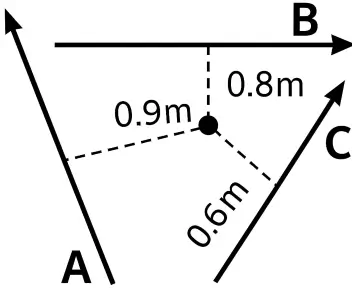
(i) Which force has the least moment about O? Give reason.
(ii) Which force has the greatest moment about O? Give reason.
(iii) Name the forces producing (a) clockwise, (b) anticlockwise moments.
(iv) What is the resultant torque about the point O?
Answer:
(i) Force C
Reason: It has the shortest perpendicular distance (0.6 m), so it produces the least moment.
(ii) Force A
Reason: It has the largest perpendicular distance from point O (0.9 m), so it produces the greatest moment.
(iii) (a) Clockwise moment: Forces A and B
(b) Anticlockwise moment: Force C
(iv) Moment by A = 4 × 0.9 = − 3.6 Nm (clockwise → negative)
Moment by B = 4 × 0.8 = − 3.2 Nm (clockwise → positive)
Moment by C = 4 × 0.6 = 2.4 Nm (anticlockwise → positive)
Resultant Torque = − 3.6 Nm − 3.2 Nm + 2.4 Nm = − 4.4 Nm (anticlockwise)
So, the resultant torque is 4.4 Nm (clockwise direction).
Question 2
A body is acted upon by two forces each of magnitude F, but in opposite directions. State the effect of the forces if
(a) both forces act at the same point of the body.
(b) the two forces act at two different points of the body at a separation r.
Answer:
(a) As two forces of same magnitude are acting on a body at the same point and they are in opposite direction so the resultant force will be zero.
\(F – F = 0\)
(b) When two forces of same magnitude act on a body at two different points at a separation r and in opposite direction then the moment of force will be \(F \times r\).
Question 3
Draw a neat labelled diagram to show the direction of two forces acting on a body to produce rotation in it. Also mark the point O about which the rotation takes place.
Answer:
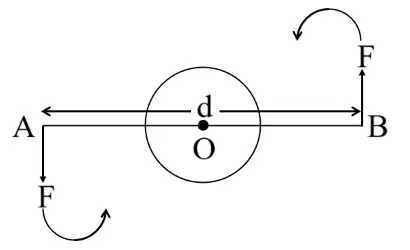
Two forces of magnitude F act at point A and point B. The body rotates in anticlockwise direction.
Question 4
What do you understand by the term couple? State its effect on a body. Give two examples in our daily life where couple is applied to turn a body.
Answer:
- Two equal and opposite parallel forces, not acting along the same line form a couple.
- A couple is always needed to produced a rotation.
- Two examples in our daily life where we use couple are:
(i) Turning a water tap.
(ii) Tightening the cap of a bottle.
Question 5
Prove that
Moment of couple = Force x Couple arm.
Answer:

At A and B two forces, each of magnitude F is applied, which are equal and opposite forces. The two forces rotate the bar in anticlockwise direction. AB is the perpendicular distance between two forces which is called the coupling arm.
Moment of force F at the end A
= F × OA (anticlockwise)
Moment of force F at the end B
= F × OB (anticlockwise)
Total moment of couple = F × OA + F × OB
= F × (OA + OB)
= F × AB
= F × d (anticlockwise)
Hence proved, Moment of force = Force x Couple arm
Question 6
Describe a simple experiment to verify the principle of moments, if you are supplied with a metre rule, a
fulcrum and two springs with slotted weights.
Answer:
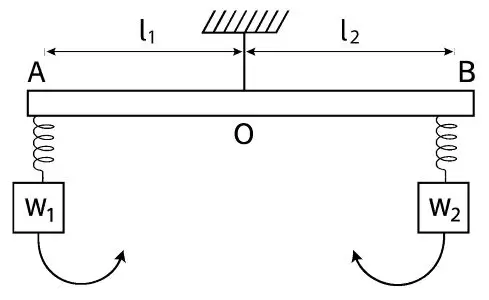
Let the distance of the weight W1 from the support be l1 and the distance of weight W2 from the support be l2. Let the weight W1 tries to rotate the scale in anti-clockwise direction. Then,
Anti-clockwise moment = W1 × l1
Clockwise moment = W2 × l2
According to the principle of moments,
Sum of the anticlockwise moment = Sum of the clockwise moment
Moment of load about the fulcrum = Moment of effort about the fulcrum
Load × Length of Load arm = Effort × Length of Effort arm
W1 × l1 = W2 × l2
Hence, the principle of moments is proved.
(E) Numericals : Exercise 1(A)
Question 1
The moment of a force of \(20\ N\) about a fixed point O is \(10\ Nm\). Calculate the distance of the point O from the line of action of the force.
Answer:
Given,
Force, \(F = 20\ N\)
Moment of force \(= 10\ Nm\)
Distance \(= ?\)
We know that,
Moment of force = Force × perpendicular distance
Perpendicular distance \(=\frac{Moment\ of\ force}{Force}=\frac{10\ Nm}{20\ N}=0.5\ m\)
Hence, distance of the point O from the line of action of the force is \(0.5\ m\).
Question 2
A nut is opened by a wrench of length \(25\ cm\). If the least force required is \(10\ N\), find the moment of force needed to turn the nut.
Answer:
Given,
Force, \(F = 10\ N\)
Length of wrench, \(d\ =\ 25cm=\frac{25}{100}m=0.25\ m\)
We know that,
\(Moment\ of\ force = Force \times perpendicular\ distance\)
\(= 10 \times 0.25\)
\(= 2.5\ Nm\)
Hence, moment of force needed to turn the nut is \(2.5\ Nm\).
Question 3
A \(50\ kg\) mass is being lifted by using a \(1\ metre\) long lever. If the length of the lever is reduced by 20%, how much more or less force is to be applied to achieve the same torque?
Answer:
Mass, \(M = 50\ kg\)
Length of lever \(= 1\ meter\)
\(g\ =\ 9.8\ m/s^2\)
Force, \(F\ = m \times g\ =\ 50 \times 9.8\ =\ 490\ N\)
\(Moment\ of\ force\ =\ Force \times Perpendicular\ Distance\ =\ 490\ N \times 1\ m\ =\ 490\ Nm\)
After Reducing Lever Length by 20%:
New lever length \(=1-\ 1\times\frac{20}{100}=\ 1\ -\ 0.2\ =\ 0.8\ m\)
New Force required \(=\ \frac{Moment\ \ of\ \ force}{Length\ \ of\ \ lever}\) \(=\frac{490\ Nm}{0.8\ m}=612.5\ N\)
Original Force \(=\ 490\ N\)
New Force \(=\ 612.5\ N\)
Difference between both force \(=\ 612.5\ –\ 490\ = 122.5\ N\)
Therefore, \(122.5\ N\) more force is required to achieve the same torque if the lever length is reduced by 20%.
Question 4
A mechanic applies a force of \(100\ N\) at the end of a spanner to tighten a bolt. The length of the spanner is \(0.5\ metres\). How much torque is exerted on the bolt ? If the mechanic increases the force applied by 20% but holds the spanner closer at \(0.4\ metres\), would it result in an increase or decrease of torque?
Answer:
Force \(=\ 100\ N\)
Length \(=\ 0.5\ m\)
Torque \(=\ Force\ \times Length\ of\ spanner\)
\(=\ 100\ N\ \times 0.5\ m\ =\ 50\ Nm\)
New Force \(=100\ N\ +\ 100\ N\times\ \frac{20}{100}\)
\(=100\ N\ +\ 20\ N\ =\ 120\ N\)
New Length \(=\ 0.4\ m\)
New Torque \(=\ 120\ N \times 0.4\ m\ =\ 48\ Nm\)
Original Torque \(=\ 50\ Nm\)
New Torque \(=\ 48\ Nm\)
Change \(=\ 50\ –\ 48\ =\ 2\ Nm\) decrease
Therefore, torque decreases by \(2\ Nm.\)
Question 5
A wheel of diameter \(2\ m\) is shown in figure with axle at O. A force \(F\ =\ 2\ N\) is applied at B in the direction shown in figure.
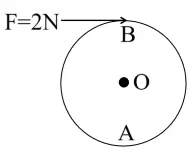
Calculate the moment of force about
(i) the centre O, and
(ii) the point A.
Answer:
Given,
Force, \(F\ =\ 2\ N\)
Diameter \(=\ 2\ m\)
Radius, \(OB\ =\ 1\ m\)
(i) Moment of force at \(O\ =\ F\ \times r\ =\ 2 \times 1\ =\ 2\ Nm\)
(ii) Moment of force at \(A\ =\ F\ \times r\ =\ 2 \times 2\ =\ 4\ Nm\)
Question 6
The diagram shows two forces \(F_1\ =\ 5\ N\) and \(F_2\ =\ 3\ N\) acting at points A and B of a rod pivoted at a point O, such that \(OA\ =\ 2\ m\) and \(OB\ =\ 4\ m\)
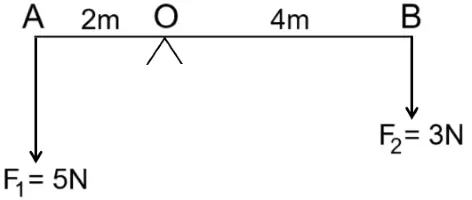
Calculate:
(i) the moment of force \(F_1\) about O.
(ii) the moment of force \(F_2\) about O.
(iii) total moment of the two forces about O.
Answer:
Given,
\(OA\ =\ 2\ m\)
\(OB\ =\ 4\ m\)
\(F_1\ =\ 5\ N\)
\(F_2\ =\ 3\ N\)
We know that,
Moment of force \(=\ Force\ \times perpendicular\ distance\)
(i) Moment of force \(F_1\) about O \(=\ 5\ \times 2\ =\ 10\ Nm\)
Therefore, moment of force \(F_1\) about O is \(10\ Nm\) (anticlockwise)
(ii) Moment of force \(F_2\) about O \(=\ 3\ \times 4\ =\ 12\ Nm\)
Therefore, moment of force \(F_2\) about O is \(12\ Nm\) (clockwise)
(iii) Total moment of two forces about midpoint is \(=\ 12\ −\ 10\ =\ 2\ Nm\)
Therefore, total moment of two forces about O is \(2\ Nm\) (clockwise)
Question 7
Two forces each of magnitude \(10\ N\) act vertically upwards and downwards respectively at the two ends A and B of a uniform rod of length \(4\ m\) which is pivoted at its mid-point O as shown. Determine the magnitude of resultant moment of forces about the pivot O.
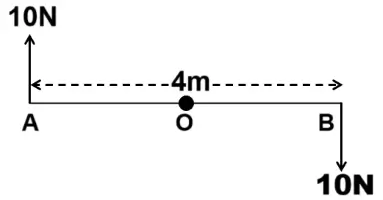
Answer:
Given,
\(AB\ =\ 4\ m\)
\(OA\ =\ 2\ m\)
\(OB\ =\ 2\ m\)
Force at \(A\ =\ 10\ N\)
Force at \(B\ =\ 10\ N\)
We know that,
Moment of force \(=\ Force\ \times perpendicular\ distance\)
Moment of force about O at point A \(=\ 10\ \times 2\ =\ 20\ Nm\) (clockwise)
Moment of force about o at point B \(=\ 10\ \times 2\ =\ 20\ Nm\) (clockwise)
Total moment of forces about the centre O \(=\ 20\ +\ 20\ =\ 40\ Nm\)
Total moment of force about the pivot O is \(40\ Nm\) (clockwise).
Question 8
Figure shows two forces each of magnitude \(10\ N\) acting at the points A and B at a separation of \(50\ cm\), in opposite directions. Calculate the resultant moment of the two forces about the point (i) A, (ii) B and (iii) O, situated exactly at the middle of the two forces.
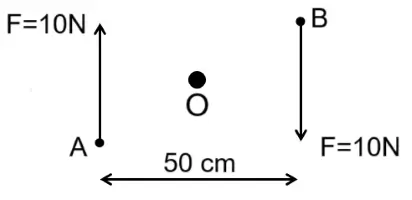
Answer:
Given,
Force at A \(=\ 10\ N\)
Force at B \(=\ 10\ N\)
Distance between A and B \(=\ 50\ cm\ =\ 0.5\ m\)
(i) Resultant moment of two forces at point A \(=\ 10\ \times 0.5\ =\ 5\ Nm\) (clockwise)
(ii) Resultant moment of two forces at point B \(=\ 10\ \times 0.5\ =\ 5\ Nm\) (clockwise)
(iii) Perpendicular distance of point O from either of the forces \(F\ =\ 10\ N\) is \(0.25\ m\)
Moment of force F at point A about O \(=\ 10\ \times 0.25\ =\ 2.5\ Nm\) (clockwise)
Moment of force F at point B about O \(=\ 10\ \times 0.25\ =\ 2.5\ Nm\) (clockwise)
Resultant moment of two forces about O is \(=\ 2.5\ + \ 2.5\ = 5\ Nm\)
Therefore, Resultant moment of two forces about O is \(5\ Nm\). (clockwise)
Question 9
A steering wheel of diameter \(0.5\ m\) is rotated anti-clockwise by applying two forces each of magnitude \(6\ N\). Draw a diagram to show the application of forces and calculate the moment of forces applied.
Answer:
Moment of couple \(=\ either\ force\ \times couple\ arm\ =\ 6 \times 0.5 \ =\ 3\ Nm\)
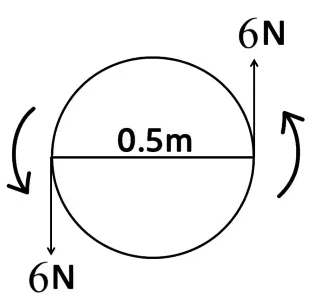
Question 10
A uniform metre rule is pivoted at its mid-point. A weight of \(50\ gf\) is suspended at one end of it. Where should a weight of \(100\ gf\) be suspended to keep the rule horizontal?
Answer:
As we know, the principle of moments states that
Anticlockwise moment = Clockwise moment
\(⇒\ 50\ gf \times 50\ cm\ =\ 100\ gf\ \times d\ cm\)
\(⇒\ d\ =\ \frac{50\ \times\ 50}{100}\)
\(⇒\ d\ =\ 25\ cm\)
Therefore, a weight of \(100\ gf\) will be suspended at a distance of \(25\ cm\) to keep the ruler balanced.
Question 11
A uniform metre rule balances horizontally on a knife edge placed at the \(58\ cm\) mark when a weight of \(20\ gf\) is suspended from one end.
(i) Draw a diagram of the arrangement.
(ii) What is the weight of the rule?
Answer:
(i) Diagram of the arrangement is shown below:
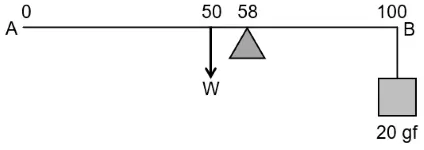
(ii) Principle of moments states that
Anticlockwise moment \(=\) Clockwise moment
\(⇒\ W \times(58\ −\ 50)\ =\ 20\ gf \times (100\ −\ 58)\)
\(⇒\ W\ =\frac{20\ \times\ 42}{8}\)
\(⇒\ W\ =\ 105\ gf\)
Question 12
The diagram shows a uniform bar supported at the middle point O. A weight of \(40\ gf\) is placed at a distance \(40\ cm\) to the left of the point O. How can you balance the bar with a weight of \(80\ gf\)?

Answer:
Anticlockwise moment \(=\ 40\ gf \times 40\ cm\)
Clockwise moment \(=\ 80\ gf \times d\ cm\)
As per the principle of moments,
Anticlockwise moment \(\ =\ \) Clockwise moment
\(⇒\ 40\ gf \times 40\ cm\ =\ 80\ gf\ \times d\ cm\)
\(⇒\ d\ =\ \frac{40\ \times\ 40}{80}\)
\(⇒\ d\ =\ 20\ cm\)
Therefore, the bar will be in balanced position if weight of \(80\ gf\) is placed at a point of \(20\ cm\) to the right of O.
Question 13
Figure shows a uniform metre rule placed on a fulcrum at its mid-point O and having a weight \(40\ gf\) at the \(10\ cm\) mark and a weight of \(20\ gf\) at the \(90\ cm\) mark.
(i) Is the metre rule in equilibrium? If not, how will the rule turn?
(ii) How can the rule be brought in equilibrium by using an additional weight of \(40\ gf\)?

Answer:
(i) Moment = Force × Distance from fulcrum
Anticlockwise moment \(=\ 40\ gf \times (50\ −\ 10)\ cm\ =\ 40 \times 40\ =\ 1600\ gf\ cm\)
Clockwise moment \(=\ 20\ gf \times (90\ −\ 50)\ cm\ =\ 20 \times 40\ =\ 800\ gf\ cm\)
Since the anticlockwise moment is greater.
The metre rule is not in equilibrium. It will turn anticlockwise.
(ii) To balance the rule in equilibrium 40gf should be kept on right side.
Let distance from middle \(=\ ‘d’\ cm\)
So clockwise moment becomes \(800\ gf\ cm\ +\ (40\ gf \times d\ cm)\)
As per principle of moments,
Anticlockwise moment \(=\) Clockwise moment
\(⇒\ 1600\ gf\ cm\ =\ 800\ gf\ cm\ +\ 40\ gf \times d\ cm\)
\(⇒\ 1600\ – 800\ =\ 40 \times d\)
\(⇒\ d\ = \frac{800}{40}\ =\ 20\ cm\)
So, we need to place the \(40\ gf\) weight \(20\ cm\) to the right of the fulcrum, i.e., at: \(50\ +\ 20\ =\ 70\ cm\) mark
Therefore, to bring it into equilibrium, place the additional \(40\ gf\) weight at the \(70\ cm\) mark.
Question 14
When a boy weighing \(20\ kgf\) sits at one end of a \(4\ m\) long see-saw, it gets depressed at its end. How can it be brought to the horizontal position by a man weighing \(40\ kgf\).
Answer:
Length of see-saw \(=\ 4\ m\)
Boy’s weight \(=\ 20\ kgf\)
Man’s weight \(=\ 40\ kgf\)
Let, man sit at a distance \(‘d’\) meter from the fulcrum.
As per the principle of moments, Anticlockwise moment \(=\) Clockwise moment
\(⇒\ 20\ kgf \times 2\ m\ =\ 40\ kgf \times d\)
\(⇒\ d\ = \frac{20\ \times\ 2}{40}\)
\(⇒\ d\ =\ 1\ m\)
Therefore, man should sit 1 meter from the fulcrum.
Question 15
A physical balance has its arms of length \(60\ cm\) and \(40\ cm\). What weight kept on a pan of longer arm will balance an object of weight \(100\ gf\) kept on other pan?
Answer:
As per the principle of moments,
Anticlockwise moment \(=\) Clockwise moment
\(100\ gf \times 40\ cm\ =\ W \times 60\ cm\)
Weight on the longer pan, \(W\ =\frac{100\ \times\ 40}{60}=\ 66.67\ gf\)
A weight of \(66.67\ gf\ (or\ 66\frac23\ gf)\) placed on the longer arm will balance the \(100\ gf\) weight on the shorter arm.
Question 16
The diagram shows a uniform meter rule weighing 100 gf, pivoted at its centre O. Two weights \(150 gf\) and \(250 gf\) hang from the point A and B respectively of the metre rule such that \(OA\ =\ 40\ cm\) and \(OB\ =\ 20\ cm\).
Calculate:
(i) the total anticlockwise moment about O,
(ii) the total clockwise moment about O,
(iii) the difference of anticlockwise and clockwise moment, and
(iv) the distance from O where a 100gf weight should be placed to balance the metre rule.
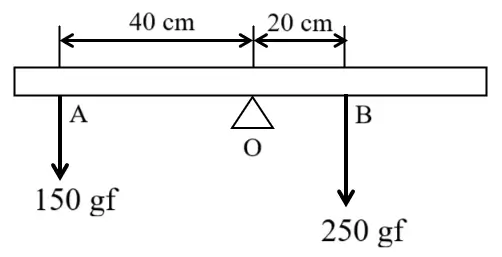
Answer:
(i) The total anticlockwise moment about the centre O \(=\ 150\ gf \times 40\ cm\ =\ 6000\ gf\ cm\)
(ii) The total clockwise moment about the centre O \(=\ 250\ gf \times 20\ cm\ =\ 5000\ gf\ cm\)
(iii) The difference of anticlockwise and clockwise moment \(=\ 6000\ –\ 5000\ =\ 1000\ gf\ cm\)
(iv) As per the principle of moments,
Anticlockwise moment \(=\) Clockwise moment
\(⇒\ 150\ gf \times 40\ cm\ =\ 250\ gf \times 20\ cm\ +\ 100\ gf \times d\)
\(⇒\ 6000\ gf\ =\ 5000\ gf\ +\ 100\ gf \times d\)
\(⇒\ d\ =\frac{1000}{100}\)
\(⇒\ d\ =\ 10\ cm\)
So, \(d\ =\ 10\ cm\) on the right side of O.
Question 17
A uniform metre rule of weight \(10\ gf\) is pivoted at its \(0\) mark.
(i) What moment of force depresses the rule?
(ii) How can it be made horizontal by applying a least force?
Answer:
(i) Moment of force = Force × Perpendicular Distance
\(=\ 10\ gf \times 50\ cm\ =\ 500\ gf\ cm\)
(ii) Force \(=\frac{500}{100}\ =\ 5\ gf\)
So, a minimum force of \(5\ gf\) applied upwards at the \(100\ cm\) mark will make the rule horizontal.
Question 18
A uniform half metre rule can be balanced at the \(29.0\ cm\) mark when a mass \(20\ g\) is hung from its one end.
(a) Draw a diagram of the arrangement.
(b) Find the mass of the half metre rule.
(c) In which direction would the balancing point shift if \(20\ g\) mass is shifted inside from its one end?
Answer:
(a) Diagram of the arrangement is shown below:
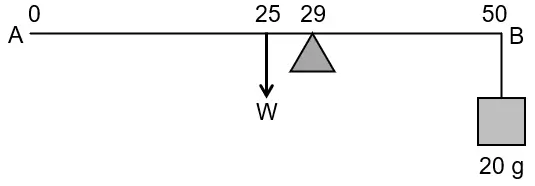
(b) Let the mass of the meter-scale be \(w_1\ gm\).
From the principle of moments,
Anticlockwise moment \(=\) clockwise moment
\(⇒\ w_1\ \times l_1\ =\ w_2\ \times l_2\)
\(⇒\ w_1 \times (29 − 25)\ =\ 20\ g \times (50 − 29)\)
\(⇒\ w_1=\frac{21\ \times\ 20}{4}\ =\ 105\ gm\)
The weight of half the meter rule is \(105\ g\).
(c) The balancing point will shift towards the \(25\ cm\) mark.
Question 19
A uniform metre rule of mass \(100\ g\) is balanced on a fulcrum at mark \(40\ cm\) by suspending an unknown mass m at the mark \(20\ cm\).
(i) Find the value of \(m\).
(ii) To which side the rule will tilt if the mass m is moved to the mark \(10\ cm\)?
(iii) What is the resultant moment now?
(iv) How can it be balanced by another mass \(50\ g\)?
Answer:
(i) From the principle of moments,
Anticlockwise moment \(=\) Clockwise moment
\(⇒\ 100\ g \times (50\ −\ 40)\ cm\ =\ m \times (40\ −\ 20)\ cm\)
\(⇒\ 100 \times 10\ =\ m \times 20\)
\(⇒\ m\ =\ 50\ g\)
(ii) The new position of \(m\ =\ 50\ g\) is now at the \(10\ cm\) mark.
Anticlockwise moment \(=\ 50 \times (40\ −\ 10)\ =\ 50 \times 30\ =\ 150\ g\ cm\)
Clockwise moment \(=\ 100 \times (50\ −\ 40)\ =\ 100 \times 10\ =\ 150\ g\ cm\)
Since the anticlockwise moment is greater than the clockwise moment, the rule will tilt to the anticlockwise side.
(iii) Resultant moment = Anticlockwise moment − Clockwise moment
Resultant moment \(=\ 1500\ −\ 1000\ =\ 500\ g·cm\) (anticlockwise direction)
(iv) Let the position be at \(x\ cm\).
Distance from fulcrum \(=\ (x\ −\ 40)\ cm\)
From the principle of moments,
Anticlockwise moment \(=\) Clockwise moment
\(⇒\ 50 \times (x\ −\ 40)\ =\ 500\)
\(⇒\ x\ −\ 40\ = \frac{500}{50}\)
\(⇒\ x\ −\ 40\ = 10\)
\(⇒\ x\ =\ 50\ cm\)
Hence, we can balance \(50\ gm\) at \(50\ cm\).
Question 20
In figure below, a uniform bar of length \(l\ m\) is supported at its ends and loaded by a weight \(W\ kgf\) at its middle. In equilibrium, find the reactions \(R_1\) and \(R_2\) at the ends.
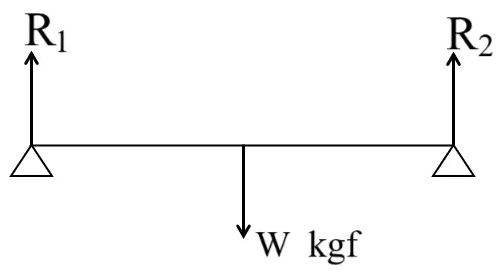
Answer:
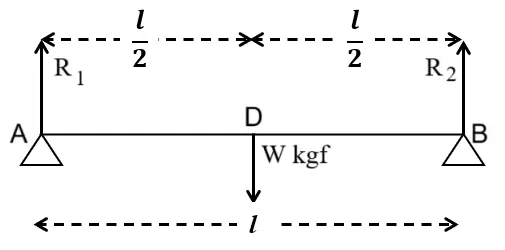
Length of the bar \(=\ l\ m\)
Weight at the middle of the bar \(=\ W\ kgf\)
As D is the mid-point of \(AB\ (l)\).
We know that,
Anticlockwise moment \(=\) Clockwise moment
In equilibrium , \(R_1\ +\ R_2\ =\ W\)
Total upward reaction \(=\ (R_1 \times AD)\ +\ (R_2 \times DB) = (R_1 \times \frac12) + (R_2 \times \frac12) = R\) (Suppose)
Total upward reaction \(=\) downward wt. of bar
\(R + R = W\)
\(2R = W\)
\(R =\frac{W}{2}\)
\(R_1 =\frac{W}{2}\ kgf\ and\ R_2 =\frac{W}{2}\ kgf\)
Download Free Selina Concise Physics Class 10 Force Solutions
You can download free PDF solutions for Selina Class 10 Physics Exercise 1(A) to revise offline. These solutions are exam-ready and designed by subject experts.
Key Features of Our Selina Solutions
- Step-by-Step Explanations: Easy-to-understand answers for all questions in Exercise 1(A).
- Concept Clarity: Covers moment of force, equilibrium, and motion with examples.
- Exam-Focused: Includes numericals, MCQs, and practice questions aligned with the ICSE syllabus.
- Free PDF Download: Access Selina Physics Class 10 Ex 1A Force Solutions anytime, anywhere.
Tips to Master ICSE Class 10 Physics Chapter 1
- Understand Concepts: Focus on definitions like moment of force and equilibrium.
- Practice Numericals: Solve all numerical problems in Exercise 1(A) to build confidence.
- Revise Regularly: Use our ICSE Class 10 Physics Chapter 1 Force Notes for quick recaps.
- Test Yourself: Attempt MCQs and practice questions to evaluate your preparation.

